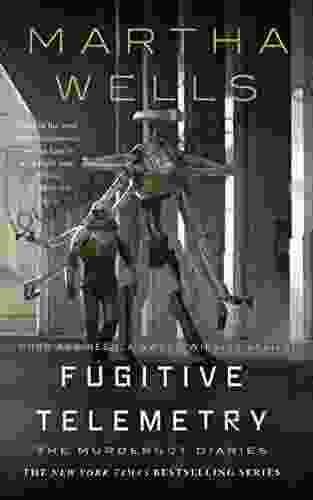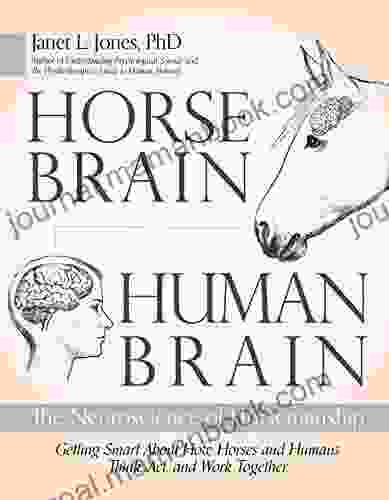Horse Brain, Human Brain: The Neuroscience of Horsemanship

Horses and humans have shared a close relationship for thousands of years, and during that time we have learned a great deal about how these animals think and learn. In recent years, neuroscience has provided us with even more insights into the equine mind, and this knowledge is helping us to develop better ways to train and care for horses.
4.8 out of 5
| Language | : | English |
| File size | : | 26962 KB |
| Text-to-Speech | : | Enabled |
| Screen Reader | : | Supported |
| Enhanced typesetting | : | Enabled |
| X-Ray | : | Enabled |
| Word Wise | : | Enabled |
| Print length | : | 333 pages |
In this article, we will explore the similarities and differences between horse brains and human brains. We will also discuss how this knowledge can be used to improve our horsemanship skills and strengthen our bonds with these amazing animals.
The Horse Brain
The horse brain is a complex organ that is responsible for controlling the horse's thoughts, emotions, and behaviors. It is divided into two hemispheres, the left and right, which are connected by a thick band of nerve fibers called the corpus callosum. The left hemisphere is responsible for logical thinking and language, while the right hemisphere is responsible for spatial awareness and emotions.
The horse brain is similar to the human brain in many ways. Both brains have a cerebrum, which is the largest part of the brain and is responsible for higher-level functions such as thinking and learning. Both brains also have a cerebellum, which is responsible for coordination and balance. However, there are also some key differences between horse brains and human brains.
One of the most striking differences is the size of the cerebrum. The human cerebrum is much larger than the horse cerebrum, which reflects the fact that humans are more intelligent than horses. Another difference is the way that the corpus callosum connects the two hemispheres of the brain. In humans, the corpus callosum is very thick, which allows for a great deal of communication between the two hemispheres. In horses, the corpus callosum is much thinner, which limits the amount of communication between the two hemispheres.
The Human Brain
The human brain is one of the most complex organs in the human body. It is responsible for everything from our thoughts and emotions to our movements and bodily functions. The brain is divided into two hemispheres, the left and right, which are connected by a thick band of nerve fibers called the corpus callosum. The left hemisphere is responsible for logical thinking and language, while the right hemisphere is responsible for spatial awareness and emotions.
The human brain is similar to the horse brain in many ways. Both brains have a cerebrum, which is the largest part of the brain and is responsible for higher-level functions such as thinking and learning. Both brains also have a cerebellum, which is responsible for coordination and balance. However, there are also some key differences between human brains and horse brains.
One of the most striking differences is the size of the cerebrum. The human cerebrum is much larger than the horse cerebrum, which reflects the fact that humans are more intelligent than horses. Another difference is the way that the corpus callosum connects the two hemispheres of the brain. In humans, the corpus callosum is very thick, which allows for a great deal of communication between the two hemispheres. In horses, the corpus callosum is much thinner, which limits the amount of communication between the two hemispheres.
The Neuroscience of Horsemanship
The neuroscience of horsemanship is a relatively new field of study that is exploring the ways in which the human brain and the horse brain interact. This research is providing us with new insights into how horses learn and how we can best train them.
One of the most important findings from neuroscience research is that horses are very social animals. They have a strong need for companionship and they are very sensitive to the emotions of others. This means that it is important to approach horsemanship with a kind and compassionate attitude. Horses are also very intelligent animals. They are capable of learning a great deal, and they are very willing to please their human companions. This means that it is important to be patient and consistent when training horses.
The neuroscience of horsemanship is still in its early stages, but it is already providing us with valuable insights into how horses think and learn. This knowledge is helping us to develop better ways to train and care for horses, and it is also strengthening our bonds with these amazing animals.
The horse brain and the human brain are both complex organs that are responsible for controlling our thoughts, emotions, and behaviors. While there are some key differences between the two brains, there are also many similarities. This knowledge can help us to better understand horses and to develop better ways to train and care for them. By working together, we can build strong and lasting relationships with these amazing animals.
4.8 out of 5
| Language | : | English |
| File size | : | 26962 KB |
| Text-to-Speech | : | Enabled |
| Screen Reader | : | Supported |
| Enhanced typesetting | : | Enabled |
| X-Ray | : | Enabled |
| Word Wise | : | Enabled |
| Print length | : | 333 pages |
Do you want to contribute by writing guest posts on this blog?
Please contact us and send us a resume of previous articles that you have written.
 Top Book
Top Book Novel
Novel Fiction
Fiction Nonfiction
Nonfiction Literature
Literature Paperback
Paperback Hardcover
Hardcover E-book
E-book Audiobook
Audiobook Bestseller
Bestseller Classic
Classic Mystery
Mystery Thriller
Thriller Romance
Romance Fantasy
Fantasy Science Fiction
Science Fiction Biography
Biography Memoir
Memoir Autobiography
Autobiography Poetry
Poetry Drama
Drama Historical Fiction
Historical Fiction Self-help
Self-help Young Adult
Young Adult Childrens Books
Childrens Books Graphic Novel
Graphic Novel Anthology
Anthology Series
Series Encyclopedia
Encyclopedia Reference
Reference Guidebook
Guidebook Textbook
Textbook Workbook
Workbook Journal
Journal Diary
Diary Manuscript
Manuscript Folio
Folio Pulp Fiction
Pulp Fiction Short Stories
Short Stories Fairy Tales
Fairy Tales Fables
Fables Mythology
Mythology Philosophy
Philosophy Religion
Religion Spirituality
Spirituality Essays
Essays Critique
Critique Commentary
Commentary Glossary
Glossary Bibliography
Bibliography Index
Index Table of Contents
Table of Contents Preface
Preface Introduction
Introduction Foreword
Foreword Afterword
Afterword Appendices
Appendices Annotations
Annotations Footnotes
Footnotes Epilogue
Epilogue Prologue
Prologue Shanna Powlus Wheeler
Shanna Powlus Wheeler Liz Reed
Liz Reed Ava Burton
Ava Burton Katy Bowman
Katy Bowman Sakurako Ono
Sakurako Ono Aleksandra Mikic
Aleksandra Mikic Colin Dodds
Colin Dodds Angela Daniel
Angela Daniel Kelly B Cartwright
Kelly B Cartwright Judy Grahn
Judy Grahn James Ford Rhodes
James Ford Rhodes Stacey Lynn
Stacey Lynn Elena V Shliakhovchuk
Elena V Shliakhovchuk Mutendwahothe Ramafamba
Mutendwahothe Ramafamba Uta Frith
Uta Frith Geraldine Helen Hartman
Geraldine Helen Hartman Rich Cohen
Rich Cohen Claire Angel
Claire Angel Magdy Halim
Magdy Halim Slaeff
Slaeff
Light bulbAdvertise smarter! Our strategic ad space ensures maximum exposure. Reserve your spot today!

 Fletcher MitchellClone Wars Gambit: An Engaging Look at Star Wars Legends and The Clone Wars
Fletcher MitchellClone Wars Gambit: An Engaging Look at Star Wars Legends and The Clone Wars Colt SimmonsFollow ·13.2k
Colt SimmonsFollow ·13.2k August HayesFollow ·15.5k
August HayesFollow ·15.5k Douglas FosterFollow ·3.6k
Douglas FosterFollow ·3.6k Jamal BlairFollow ·4.3k
Jamal BlairFollow ·4.3k Ken FollettFollow ·15.8k
Ken FollettFollow ·15.8k Gary ReedFollow ·17.3k
Gary ReedFollow ·17.3k Gerald BellFollow ·13.2k
Gerald BellFollow ·13.2k Cruz SimmonsFollow ·18.2k
Cruz SimmonsFollow ·18.2k

 Alexandre Dumas
Alexandre DumasFugitive Telemetry: Unraveling the Secrets of the...
In the realm of...

 Caleb Carter
Caleb CarterBlack Clover Vol 25: Humans and Evil - A Journey into the...
Unveiling the Sinister Forces Black...

 Israel Bell
Israel BellHow to Make Offers So Good People Feel Stupid Saying No
In today's competitive business environment,...

 Simon Mitchell
Simon MitchellWrath of Hades: The Children of Atlantis
An Epic Tale of...

 Percy Bysshe Shelley
Percy Bysshe ShelleyStrengthen Your Immune System: Fight Off Infections,...
What is the...

 Clark Bell
Clark Bell10 Things I Wish Someone Had Told Me Earlier
As we navigate through life, we accumulate a...
4.8 out of 5
| Language | : | English |
| File size | : | 26962 KB |
| Text-to-Speech | : | Enabled |
| Screen Reader | : | Supported |
| Enhanced typesetting | : | Enabled |
| X-Ray | : | Enabled |
| Word Wise | : | Enabled |
| Print length | : | 333 pages |









